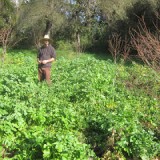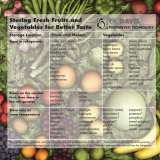
I’m struggling this morning for metaphors to describe our summer vegetable and fruit garden: Napoleon at Waterloo, the Hindenburg disaster, being locked in a cell with a recording of “Achy Breaky Heart” in a continuous loop. In short, growing edibles this year was an unmitigated disaster. Here’s a few of the things that happened:
- We planted a bed of basil seeds and got lambsquarters (Chenopodium album) instead. Yes, I know lambsquarters are edible, but I was looking forward to the basil.
- Our Swiss Chard, usually a good performer, was stunted and anemic. It seemed incapable of growing past 8 inches.
- Our tomatoes grew well, produced a fair amount of fruit and then abruptly dried up and croaked.
- We planted zucchini too late and it got a bad case of powdery mildew.
- The raccoons figured out how to bust through the bird netting that was supposed to keep them out of the vegetable beds. They completely obliterated two out of four vegetable beds.
- With the exception of our pomegranate tree, every last peach, apple, persimmon and most of our figs were harvested by squirrels and raccoons.
- The Nectaplum, Santa Rosa plum and nectarine trees did not produce a single fruit due, I think, to a lack of chill hours caused by climate change.
- Drought, of course, made everything worse. We had to water our already alkaline soil with alkaline water. Only the native plants and what we call the Biblical plants seem happy (e.g. the fig and the pomegranate).
- The drought and an extreme heat wave pushed everything in the garden to the edge–and a few over the edge: in the last month we abruptly lost some garden stalwarts, including a rosemary bush and a culinary sage.
Despite all these disasters, I came back from the Heirloom Expo with some ideas:
- Spend a little less time on Facebook and a little more time in the garden.
- Come up with better raccoon fortifications.
- Take out stone fruit that isn’t performing (Kelly has wanted to do this for a long time but I’ve dragged my heels).
- Take better notes.
- Improve soil and restart a composting project.
- Come up with small metal cages to enclose fruit (I have a notion that involves 3D printing–more on this later).
How did your garden do this summer?





Your story is a familiar one over here as well, but I’ve taken notes, and next years garden will be better.
Your garden sounds like my Central Texas garden, down to the critter damage. I’ve found a way to protect melons, squash and pumpkin: let the fruit grow in a plastic pot with a hardware cloth “door” wired to the top. But I am mightily tired of losing fruit tree crops to raccoons/ possums/ birds/ squirrels.
For that chard – as you pull up the stumps, see if you have root knot nematode galls on the roots. Your above-ground symptoms match ours, and that’s what we discovered below ground. Here’s what we’re doing to treat it: http://www.change-making.com/root-knot-nematodes/
Tomato symptoms might be root knot, or might be need for deep water and soil nourishment. I have been reading that with increased heat, the decomposition in the soil speeds up dramatically, so we will go through/deplete organic material from our soils much faster.
For stone fruit replacements (sorry, I’m voting on Mrs Homegrown’s side), use a quality nursery that tells you chill hours by specific variety. We use Bay Laurel in Atascadero. Order now, and dig your holes, and your trees will arrive after the first of the year.
Rodents even took out my pomegranates (ate them from the inside out), so my sympathies. My guess is the drought really gave the urban rodent population extreme hardship this year, so they turned to fruit trees in desperation.
I hate to rub salt into wounds, but at the Community Garden at Holy Nativity, we have had one of our most amazing hot seasons ever. We used straw leftover from a certain project as thick surface mulch in the garden. I’ve also been applying the ideas about rapid crop turnover from Paul and Elizabeth Kaiser’s amazing podcast http://www.resilience.org/stories/2015-05-27/paul-elizabeth-kaiser-sustainable-farming-2-0
Joanne– I just found your comment buried in the spam files. I’m so sorry! But thanks so much for the great ideas!
Ugg. No garden loveliness happening at our house this year. The heat/cold cycles were so far askew that, as you experienced, things started at the wrong time and then got themselves dead right quick. 🙁 Thankfully, I was way too busy with some other things to do much in the yard this year, so I didn’t lose as much as I would have otherwise. I am happy to see that it looks like we may have a bumper crop of japanese persimmons this year as long as my dogs don’t keep “pruning” to get to the green ones 😉
Not quite sure where you are in LA, but the story is exactly the same here in Monterey Park 7 miles east of Los Angeles. Pluots and apples did not set any fruit. Pomegranate growing great. Persimmon has fruit but it’s early days yet and although the birds have found it, the squirrels have not. I got the first of the Asian pear crop and the squirrels got the rest. All vegetables failed except early cucumbers and chile peppers. A Brazilian pepper tree is dying after fifty years. Sigh.
I’m beginning to think that I need to plant my “spring” crops in November and “summer” in January or February and just forget about trying anything productive in this crazy heat.
That is exactly what I do here in zone 10a in San Diego.
Most Tomatoes go in, in Jan, or February, and most spring crops go in between October, and November. Been doing this for about 4 seasons now, and it seems to work.
Like BetsyR above, my Central Texas garden fared as well as yours. Flooding rains took out all of our 5 raised beds and then we had zero rainfall for about 50 days. My tomatoes looked like yours, when they were finally pulled out yesterday in preparation for fall gardening. The few figs that showed up were promptly devoured by birds before they were remotely close to being ripe. I did have a single peach this year, which never ripened and is still stuck to the tree. The birds have even ignored it. SIGH. I’m thinking of switching gears and planting medicinal herbs instead of veg and fruit. Less heartache.
We had a similar experience this year in Orange County. Our low-chill nectarines (Snow Queen & Panamint) produced nothing but leaves, our tomatoes were nice in May/June and then abruptly stopped and died. My cucumber plants never grew beyond 6″. The pomegranate has done great and we even had some ripe fruit in June/July. Just last week, it has started blooming again while the branches are full of fruit! I am thankful that we do not have to rely on our harvest to survive because I’m pretty sure we would have starved this year.
Eastern PA here and I also had the worst year . Warm early then frost then rain. Earliest tomatoes ever then all got blight which is a huge problem here. Then drought!. Every plant had some disease including my Basil which had rust . Squirrels dug up potatoes – ran off with cukes and I actually saw a bunny nibbling on my tomatoes. Planted fall garden – cabbages kale and collards keeping fingers crossed
Washington had the driest summer on record. I call it The Lost Summer.
I am on a shared well and cannot exactly let it water just run. I had to mulch the mulch and it only helped a little. My chard, that I planted in April, only started really growing in September.
Everything else is a blitzed, hot mess. I did put together a dripline system for new trees and shrubs (thank you Making It). Anything that got a drippily spout at least survived, though “thriving” would be a stretch.
The one major success was that the very sad Santa Rosa plum I inherited finally had sufficient cross-pollinators and was healthy enough to actually bear this year. The tree had been essentially barren until this year.
Regrouping and rethinking for next year.
In Northern California, we managed tomatoes (mostly cherries, it’s not really hot enough in Oakland to do the big ones and the irregular watering made the few we did have split or get blossom rot), basil, and lots of herbs. The fig tree did fantastically, the drier the better it seems for them. So yeah, natives and “biblical” plants! It was not the best year for the garden but it wasn’t a total loss despite the severe drought, so that seems like a win overall.
Our gardens were mediocre. Fruit trees bare. I did harvest a goodly quantity of fine compost for next year!
Were you the source encouraging mushrooms as compost? I have picked and scattered and composted a hundred pounds or more this year.
Here in the High Desert we still have cherry tomatoes coming in (cherry tomatoes seem to be best for the desert) and I’ve had a good variety of peppers. From the trees: apples and figs and a couple of peaches (the squirrels got the rest). Mint in a pot, rosemary and lavender, plus the sages are happy. Everything else either stolen by varmits or did not make it. But I am looking forward to lots of onions for this winter. No purslane, though, which usually grows like a weed. I missed it in salads and scrambled eggs.
Consider looking at Tohono O’Odham and Pima heirloom cultivars for your vegetables. Soil in southern AZ is very alkaline, and the cultivars carried by Native Seeds/SEARCH are going to respond better to both drought conditions and alkalinity. Desert heirlooms are the very best in low-water conditions, and most also had to cope with alkalinity, so they remain better-adapted than cultivars from other regions even when there’s no water shortage.
Another thing that helped me grow effectively in very alkaline soil: incorporate coffee grounds in quantity. Not only are they a decent nitrogen source, but they’re also acidic. Don’t run them through a compost system, but use them straight on the soil surface like a mulch. Coffee shops will often let you collect theirs–I had two lidded 5-gallon buckets I gave to the coffee shop so they could dump grounds straight from their machines and it was easy to switch the buckets out weekly.
Pine needles can also help as a surface mulch that adds some acidity. I didn’t use them with fruiting vegetables, but around trees and in beds I was building but not yet using they worked really well. If you can find a free source.
I fed my family mostly from our garden despite a measured pH of 8.5 and very low water availability (<9" year total precipitation) and 110+ summer temperatures, so it is definitely possible with some alterations in approach.
Valley Permaculture Alliance, in Phoenix, is another good source of information on low-water growing. Tucson also has quite a few drylands resources if you poke around.
Feeling lucky here in the Mitten. Our problem was too much rain- over 9 inches in June alone, but my gardens have good drainage so it didn’t cause too many problems. Things could have done much better if I’d had more energy to put into it, but being pregnant and working full time I was very happy with our yields! Hundreds of pounds of tomatoes, plenty of greens, potatoes, okra, too much eggplant, cucumbers, etc. Many of my crops succumbed to disease early, probably a combo of wet weather and me not having energy to do anything to combat it, but we got plenty before things died as it was. Full freezer and pantry to go int this winter!
Isn’t gardening fun!
Ed Morrow
Carmel Valley, CA
Odd summer garden at my house too. Early tomatoes from the heat but got attacked by vicious spider mites infestation. Tomatillos came in very late, like now but are getting killed by leaf miners. Powdery mildew is my nemesis! Kale being devoured by green caterpillars. Cucumbers doing okay. Must have had a bunch of baby grasshoppers hatch because they’re everywhere eating everything. Figs did good but fig beetles ate half the harvest. And ants must be desperate because they’re everywhere trying to farm aphids on everything. Must be a tough drought for the bugs.
It was an odd summer in the UK too- hot early on and then damp (ok, wet) and cooler.
This is my first year in a new garden. It has zero soil (Most of it it used to be a field and has not been improved at all. Heavy clay means it’s impossible to just dig a new bed) and so experiments with straw bale gardening have added to my rather patchy results whilst I lasagne mulch in preparation for (a hopefully better year) next year.
It was a bad year for tomatoes in the South. The standouts from a brutal summer are okra and Thai roselle hibiscus. The late pole beans I planted are bearing nicely, but with the varietal name of Rattlesnake, I figured I’d get something 🙂
Here in Denver we’ve had one of the worst gardening years even in a plethora of recent bad gardening years. A wacky winter last year caused a lot of folks to lose their fruit trees (I lost a cherry) Then a cold and wet/rainy spring where plants planted in early June didn’t get going until July (and many perrenials hardly bloomed at all.) I have drowned at least a 1000 Japanese Beetles (I kid you not) as they are legion this year. The squirrels are eating all my tomatoes and even going after pumpkins with tabasco sauce on them – must be a delicacy. All I can say is thank God there are still grocery stores or else I would be in real trouble 🙂 Peace, Tanya
We’ve had more rain this year than the past five, but alas, it didn’t help the fruit trees – a late frost after a early spring warm up did in most of the blossoms. The rain has brought bugs and rodents up the wazoo both into the garden and house. Including a 2″ millipede that woke me up in the early AM by crawling in my ear. I couldn’t get it out till my neighbor woke up to help. Many of the critters that attack the garden I’ve kept at bay with an electric fence. Easy to do and cost-effective for everything except the squirrels.
Well, totally different summer here in the Netherlands, although also quite disastrous. For a while everything was great – mild, warm, the occassional shower – and all our veggies and herbs performed superbly. End of august came, and the weather turned. Torrential rains and gusty winds obliterated most of my tomatoes (blight, blight, and more blight), peppers (just not enough heat), zucchini (powdery mildew and tons of slugs that ate every last flower and young fruit) and even our onions and leeks started rotting. Next year, I will plant the tomatoes and peppers in a small passive greenhouse, and the zucchini further apart…not sure yet what to do about the slugs though…only the green beans and parsnips seem to be going strong. So, very different, but also extreme conditions here in NW-Europe!
here in N. CA. in the north bay, I had some success and some failures, which is always the case in gardening, although this year’s weather has been challenging to put it mildly. I had a great onion crop (planted last November from seed I saved) My tomatoes did well, though they are suffering from heat. Decent pepper crop, but they are getting sunburned and not finishing well. With the fruit trees, you need to attach a metal collar at the bottom of the tree…it at least keeps rats from climbing up and ruining the crop.
Here in South Florida (zone 10b), we tend to stop growing when the humidity has super saturated the air, frizzed our hair and it’s dead calm, hee hee, usually about May/June. On top of it this summer very dry. The sun and heat just about burns everything up, so it’s a good time to give the garden soil a rest and I can catch up on researching what to grow for fall. Right now in the ground I have glass gem corn, ‘beit alpha’ cucumbers & sugar snaps. Soon to go in the ground are some habanero peppers, sweet banana peppers, calendula ‘pink surprise’,’broad windsor’ fava beans, a large cherry tomato variety and yellow wonder wild strawberry. Many of these are first’s for me as well as growing in our new home in a different part of the city, so will see how we all do, lol. Thanks so much for all your insight and great work! Happy Gardening! Sheri B.
Ahhhh, this is making me feel SO much better! My garden was also disastrous. Strawberries, cabbages, broccoli, and everything else green got eaten by turkeys. My green bean teepee produced gargantuan, stringy, inedible things and finally yellowed away to nothing. The spinach and arugula also failed to produce–and not one of my hot pepper or lavender seeds even came up.
The one thing that did very well, however, was my chamomile plant. I got a whole tablespoon of tea from it.
Next season: herbs and flowers!
PS: I’m in Boston. Hot, dry, cold, wacky summer.
yup “do everything with better hopes for next year” should be on some t-shirt or cross stitched over my door, the year before last…..
Have you tried metal bands around your trees? We use it to rodent proof coconut trees. They look like this
http://i.imgur.com/ML8AmGJ.jpg
late to reply, but the results at my house (near Sac) were abysmal. Between heat stress stunting growth of annuals and probably-depleted soil not helping. It all just withered up at some point. I’ve sent out for a soil test and will go from there… still coming up with the plan for perennials, but I too, see pomegranates and figs in my future.
I don’t have enough sun on postage sized lot for much of a garden. But we have a cherry tree and I have NEVER seen such incredible fruit as we had this year. There were so many beautiful cherries that the birds were totally irrelevent. In fact, I think that there were so many cherries that the birds were intimidated and didn’t even bother showing up. I canned lots of cherries for January.
I also planted some asparagus in my boulevard and tossed on some compost to top dress the roots. This led to a multitude of volunteer roma tomatoes. They got some sort of blight or something that led to rotting tomatoes, but I have still got lots of good ones to eat. The neighbour went big time into tomato production and her entire crop got nailed by blight (it was cool and wet for a lot of weeks, so this is understandable.) I haven’t told her that I got a ton of tomatoes by accident whereas she got nothing for a lot of work and about $100 worth of investment. 🙁
But this is in Southern Ontario—which climate change seems to have made cooler and wetter rather than everywhere else which has gotten hotter and drier.
Like the other midwesterner from ‘The Mitten’, this Illinoisan had a incredibly abundant year from annuals, perennials and tree crops. And now the mushrooms… Soil work, compost work and seed/tree selection is going to be an on-going project for all California gardeners.
Erik and Kelly, Don’t be shy to turn half of your backyard into compost piles!I
Probably not much consolation for me to tell you that things were the same up the hill at Camp Waterloo. Exactly the same. Tomatoes: Sauce tomatoes did well so I made a ton of sauce from their one harvest. We ate a few fresh ones from the regular tomatoes, and then there was the dried up death (and this from indeterminate varieties). Cucumbers never even flowered. Green beans: one harvest and then more of the dried up death. Squash: exactly two fruits from each vine, then DUD. Peppers: scanty. Eggplant: same as cucumber. Fruit trees barely even flowered (so of course my bees absconded), and the squirrels now rule the lower forty; I harvested not a single fruit this year. Mind you, this was even with a carefully programmed and controlled drip watering system. Those goddam trees of heaven are soaking up all the moisture, as far as I can tell, because they are doing just fine. Has anyone ever experimented with them as a food crop? I could be a millionaire.
Probably because nothing was really growing much, I had no problems with critters in the beds. Mine are individually fenced, though, and I have a dog who keeps vigil 24/7. The one bright light of the summer has been the the chickens, who have been laying like wonder women since the beginning of the year. Only starting to slow down a little due to fall molt.
I’m not totally discouraged, but it’s getting to be such a lot of work for such small return that I sometimes wonder……
A “Waterloo” on Waterloo! Good to hear from you Sue–hope things are good with you otherwise. And regarding tree of heaven–they are medicinal and I once met some artists who were using them for woodworking projects: http://www.treeofheavenwoodshop.com/.
Ours was half disastrous as well here in upstate NY. Half the garden was destroyed by a hateful neighbor who sprayed roundup on it. The rest was hurt by a terribly cold, late winter followed by a rainy spring and extremely dry summer. We’re giving up on the more exposed space and hoping for better things next season.
Not been keeping up on your exploits, catching up a bit today. Here at 4500 feet in AZ we’ve had an interesting year also. After two years of having gophers dig into all our garden beds, we dug out and reinforced some, and expanded the large container/grow bag efforts to include several 100 gallon grow bags set up on wire covered wooden pallets. Lots more rain that usual this year which was great for the large rain harvesting containers (total 1650 gallons) we installed and kept us from having to “buy” our water. Here we tend to have about a six week spring grow season and then a later summer/early fall one. Not much happened until the late summer when things went nuts. More zucchini through this last September/October from one June planted seed than I got out of 6 spring plants! green beans did poorly – although used commercial seed rather than my saved seed. The fourth planting from saved seed produced more, quicker, than I got from 3 plantings of commercial seed. Chard was also so so. Roma tomatoes did mediocre to okay until August when they began producing and growing like mad and are still putting out new fruit here in early October. Also spaghetti squash suddenly started producing late summer when usually it is done – bigger fruits than usual too! Potatoes did poorly. Eggplant did poorly. Did get 6 delicious figs from the newly planted fig tree though and added some blueberry bushes and a Kiwi also. Nice thing about containers is I can control acid environment for the blueberries and fruit trees, while the more basic environment that the new asparagus needs! For the first time I was not the only veggie gardener in the neighborhood, with two others on our street adding gardens. They also had mixed results, both doing different techniques than I do. So we’ve had a chance to share what was plentiful, fortunately, different things for different people and we all enjoyed plenty of fresh produce this year.